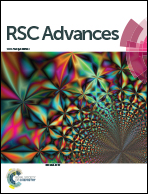Kinetics and mechanism of degradation of chitosan by combining sonolysis with H2O2/ascorbic acid
Abstract
This study demonstrated the combined use of sonolysis with the H2O2/ascorbic acid (Vc) redox reaction to degrade chitosan (CS). The influence of operating parameters, such as the initial CS concentration (1–15 mg mL−1), the input power level (15–45% of the total input power), the H2O2 and Vc concentration (10–70 mM) and the pH (3.0–5.0) of the reaction solution, on the molecular weight and degradation kinetics of CS were investigated and optimized. Based on the degradation kinetics, a synergetic effect of sonolysis with H2O2 and Vc on the degradation of CS was observed. Structural analysis by FT-IR and 1H and 13C NMR indicated no significant difference between the chemical structure of chitosan before and after degradation. Moreover, intermolecular hydrogen bonds were broken, and the crystallinity of degraded chitosan decreased. Using the above analysis, CS degradation by the combination of sonolysis with the H2O2/Vc redox reaction was proposed to be due to mechanical effects along with HO˙ attack on the β-1,4-glucoside linkages of glucosamine units. These results suggest that the sonolysis/H2O2/Vc combined technique is promisingly suitable for large-scale manufacture of chitooligosaccharide.


 Please wait while we load your content...
Please wait while we load your content...